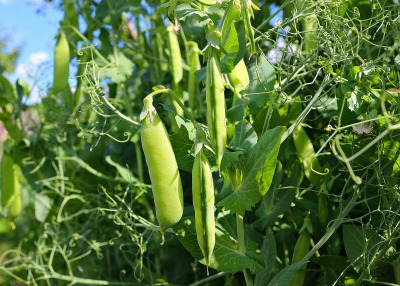Gregor Mendel used the common garden pea in his experiments the results of which became the basis of the science of genetics.
It was not by accident that it became his experimental plant.
Even from the start, he was already aware that the right experimental plants must be used in order to avoid the “risk of questionable results”.
Consequently, he developed criteria in the selection of test plants for his study.

What Characteristics Should the Experimental Plant Have?
As a guide which finally led to his use of the garden pea, he considered that his experimental plants must have the following traits:
1. They must possess constant differentiating characters.
The parents in each cross ought to differ in one set of characters (for example smooth or round or roundish seeds vs. wrinkled seeds) and each parent must maintain the character in the succeeding generations.
Such plants are now called purelines;
2. The hybrids of such plants must, during the flowering period, be protected from the influence of all foreign pollen, or be easily capable of such protection.
The experimental plants must be protected, either as a natural trait or artificially, from pollen contamination; and
3. The hybrids and their offspring must maintain fertility to the fullest in the succeeding generations.
Stated another way, both partial and complete sterility must be inexistent.
This is because the outcome of the hybridization needs to be strictly monitored from generation to generation.
Thus he proceeded in identifying the most qualified experimental plants.
He focused on the members of the family Leguminosae (now alternatively called Fabaceae) because of their unique floral structure.
Their flowers are clearly visible and the parts, particularly the pistil and the stamen, are easily distinguishable.
Finally, he identified the genus Pisum to have possessed the essential qualities.
For two years he conducted preliminary studies on 34 varieties of garden pea (mainly Pisum sativum) which he obtained from several seedsmen with more or less distinct characteristics.
However, only 22 exhibited constant characteristics.
From these, he selected the experimental plants (7 P1 plants and 7 P2 plants) for his studies that differed in seven characters.
What Characteristics of Garden Pea Convinced Mendel?
The following characteristics of garden pea convinced Mendel that it was the right species for use as experimental plant:
1. It exhibited characters that are constant and easily recognizable such as the texture of seed, height or stature, the color of specific plant organs, etc.;
2. Some forms of the genus exhibited contrasting traits such as smooth vs. wrinkled seeds, short vs. tall height, axillary or terminal flowers, etc.;
3. Hybrids and their offspring are fertile, that is, continuous cross- and self-fertilization were possible and the seeds maintained viability;
4. It is highly naturally self-pollinated because the reproductive parts of the flower are covered by the keel (petals) which only opens after pollination has been completed. This phenomenon is now called cleistogamy;
5. These plants are easy to grow either on the ground or in pots;
6. The plants have short maturity; and
7. Although the cross-pollination methods are somewhat complicated, the results are largely successful.
The procedure consisted of the opening of the young bud, removal of the keel, removal of the stamen using forceps (emasculation), and a dusting of the stigma with the pollen from the specified parent plant.
Mendel noted that the following possibilities might have caused an error in the results (Rook 1964):
First, he said that insects, notably the beetle Bruchus pisi, open the flowers of a garden pea to lay eggs inside.
In so doing, some pollen adheres to their tarsi.
This could lead to unintended pollination of some flowers that they may visit.
However, he did not mention thrips and this, Prof. W. Bateson noted as he edited the translation of Mendel’s original paper for the Royal Horticultural Society of London, was an error.
Second, he mentioned that in rare cases certain parts of a flower wither resulting in the partial exposure of the reproductive organs.
This can lead to the introduction of foreign pollen.
Third, the keel may not be fully developed which may also partially expose the reproductive organs.
Fourth, it was observed that sometimes the pollens are not fully developed.
In this case, the pistil gradually lengthens until the tip of the stigma protrudes from the keel.
However, Mendel observed that out of more than 10,000 plants examined, there occurred only a few cases of contamination or “false impregnation” of foreign pollen.
Note: Despite the meticulousness of Gregor Mendel, it is possible that his selection of garden pea as an experimental plant was also attended by some element of luck.
As already mentioned on the main page, he attempted to show that his derivations are also true to other plants.
If only it became successful, it would have possibly lead to the timely recognition of his findings.
Unfortunately, he selected the hawkweed as his second experimental plant, an apomict.
As such, the offsprings are clones of the plant from which the seeds are derived.
There is no fertilization and therefore only the traits of the maternal parents are transmitted (click to read the significance of apomixis in plant propagation).
REFERENCES
MENDEL G. 1865. Experiments in Plant Hybridisation. (Translation of the Royal Horticultural Society of London). Retrieved Nov. 2, 2013, from https://ia600409.us.archive.org/15/items/experimentsinpla00mend/experimentsinpla00mend.pdf.
ROOK A (ed.). 1964. The Origins and Growth of Biology. Harmondsworth, Middlesex: Penguin Books, Ltd. p. 294-311.
